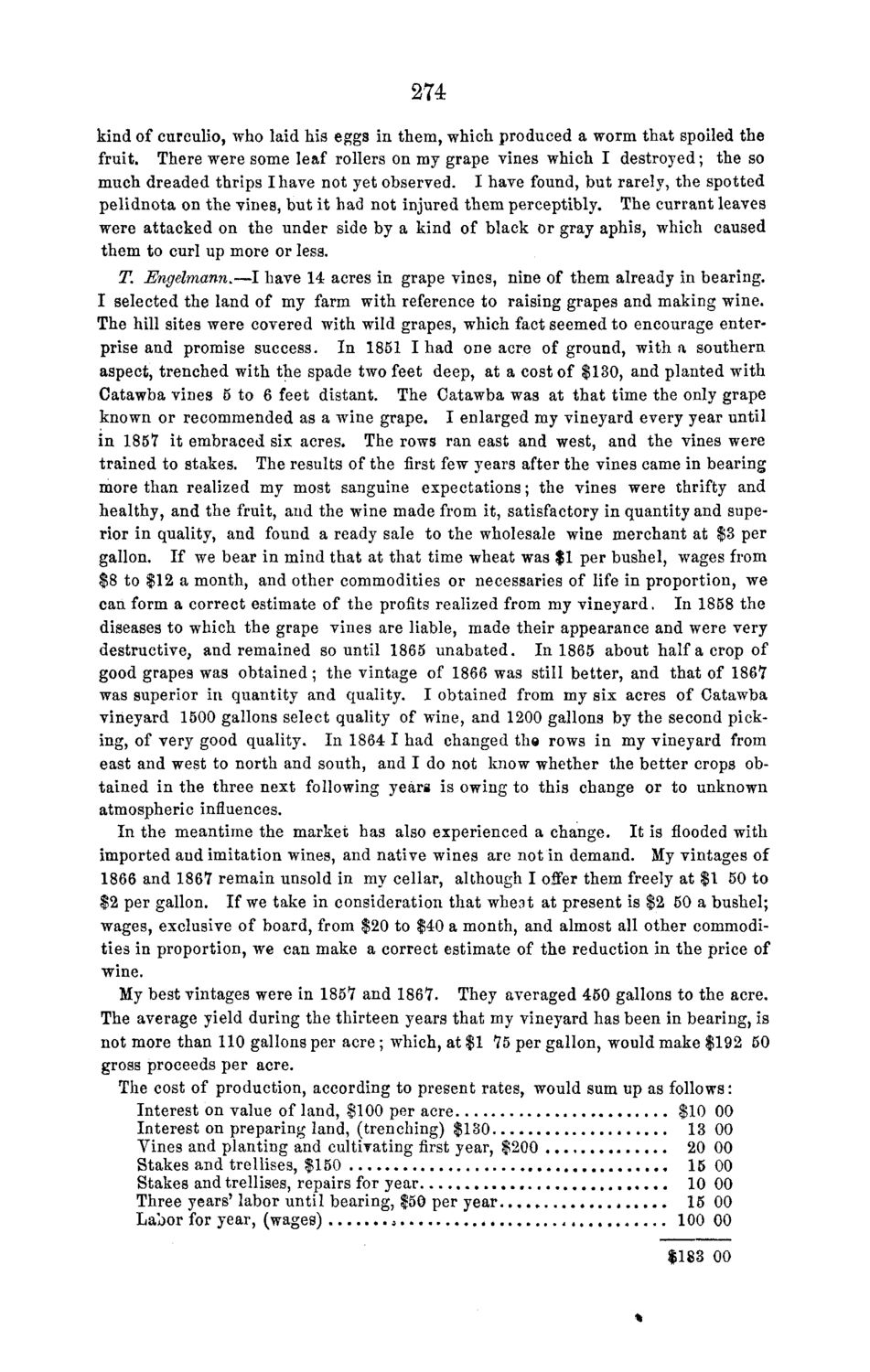| |
| |
Caption: Board of Trustees Minutes - 1868
This is a reduced-resolution page image for fast online browsing.

EXTRACTED TEXT FROM PAGE:
274 kind of curculio, who laid his eggs in them, which produced a worm that spoiled the fruit. There were some leaf rollers on my grape vines which I destroyed; the so much dreaded thrips I have not yet observed. I have found, but rarely, the spotted pelidnota on the vines, but it had not injured them perceptibly. The currant leaves were attacked on the under side by a kind of black or gray aphis, which caused them to curl up more or less. T. Engelmann.—I have 14 acres in grape vines, nine of them already in bearing. I selected the land of my farm with reference to raising grapes and making wine. The hill sites were covered with wild grapes, which fact seemed to encourage enterprise and promise success. In 1851 I had one acre of ground, with a southern aspect, trenched with the spade two feet deep, at a cost of $130, and planted with Catawba vines 5 to 6 feet distant. The Catawba was at that time the only grape known or recommended as a wine grape. I enlarged my vineyard every year until in 1857 it embraced six acres. The rows ran east and west, and the vines were trained to stakes. The results of the first few years after the vines came in bearing more than realized my most sanguine expectations; the vines were thrifty and healthy, and the fruit, and the wine made from it, satisfactory in quantity and superior in quality, and found a ready sale to the wholesale wine merchant at $3 per gallon. If we bear in mind that at that time wheat was $1 per bushel, wages from $8 to $12 a month, and other commodities or necessaries of life in proportion, we can form a correct estimate of the profits realized from my vineyard. In 1858 the diseases to which the grape vines are liable, made their appearance and were very destructive, and remained so until 1865 unabated. In 1865 about half a crop of good grapes was obtained; the vintage of 1866 was still better, and that of 1867 was superior in quantity and quality. I obtained from my six acres of Catawba vineyard 1500 gallons select quality of wine, and 1200 gallons by the second picking, of very good quality. In 1864 I had changed the rows in my vineyard from east and west to north and south, and I do not know whether the better crops obtained in the three next following years is owing to this change or to unknown atmospheric influences. In the meantime the market has also experienced a change. It is flooded with imported and imitation wines, and native wines are not in demand. My vintages of 1866 and 1867 remain unsold in my cellar, although I offer them freely at $1 50 to $2 per gallon. If we take in consideration that wheat at present is $2 50 a bushel; wages, exclusive of board, from $20 to $40 a month, and almost all other commodities in proportion, we can make a correct estimate of the reduction in the price of wine. My best vintages were in 1857 and 1867. They averaged 450 gallons to the acre. The average yield during the thirteen years that my vineyard has been in bearing, is not more than 110 gallons per acre; which, at $1 75 per gallon, would make $192 50 gross proceeds per acre. The cost of production, according to present rates, would sum up as follows: Interest on value of land, $100 per acre $10 00 Interest on preparing land, (trenching) $130 13 00 Yines and planting and cultivating first year, $200 20 00 Stakes and trellises, $150 15 00 Stakes and trellises, repairs for year 10 00 Three years' labor until bearing, $50 per year 15 00 Labor for year, (wages) , 100 00 $183 00
| |